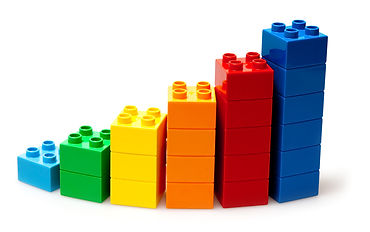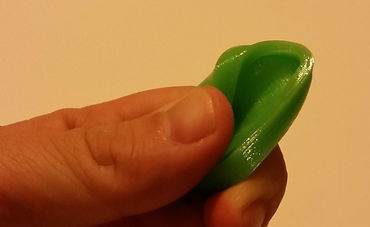PLA
Made out of corn. Makes this plastic realy good for the enviroment and its also PET friendly for recycling. This plastic is also non toxic wich makes it perfekt for food utensils and childrens to play with. When melting in the 3D printer it doesent oze and dont give any smell thats needs to be ventilatied. The durability of PLA make its also good for gears and non flexible items were you are looking for some extra strength. The downside is when stretched or bendt to much it will snapp off without any warning at al.
Printing temperature betwin 185-215°C
Max printing speed 90mm/s
Heatbed Not Needed
When printed
Max temp exposure before warping 60°C
Materials and its up and downs
All materials have different kinds of use.
You need to know what the different types are good for to get the moust out of your prints.
So here below you have a short description in the materials i use.


ABS
ABS as a polymer can take many forms and can be engineered to have many properties. In general, it is a strong plastic with mild flexibility (compared to PLA). The flexibility of ABS makes creating interlocking pieces or pin connected pieces easier to work with. It is easily sanded and machined. Notably, ABS is soluble in Acetone allowing one to weld parts together with a drop or two, or smooth and create high gloss by brushing or dipping full pieces in Acetone. Compared to PLA, it is much easier to recycle ABS.
Its strength, flexibility, machinability, and higher temperature resistance make it often a preferred plastic by engineers and those with mechanical uses in mind.
Printing temperature betwin 220-245°C
Max printing speed 90mm/s
Heatbed 100°C
When printed
Max temp exposure before warping 85°C

NinjaFlex
Open a world of possibilities, limited only by your imagination. NinjaFlex™, a cutting-edge filament for 3D printers, is a specially formulated thermoplastic elastomer (TPE) that produces flexible prints with elastic properties. Comes to its best use as gaskets, lenscovers, armbands etc. In the picture to the top left you can se my own design of a wineariator and the green gaskets or seals are made of ninjaflex to make a absolut tight seal to the winebottle.
Printing temperature betwin 210-225°C
Max printing speed 50mm/s
Heatbed 30°C
When printed
Max temp exposure before warping 66°C

T-Glass
Taulman t-glase is derived from the strongest PETT polymer combination available in the market. As t-glase is part of the Taulman3D family you can be sure that t-glase is a strong material! Where Taulman’s 618 and 645 nylons are quite bendable, t-glase is however a fairly stiff material. When it comes to stiffness/bendability t-glase is more comparable to ABS and PLA, rather than to Taulman’s 618 and 645 nylon filaments. Taulman t-glase filament comes in a “clear” colour, as clear is the natural colour for this type of polymer. When summarising above features the conclusion is that Taulman’s t-glase filament is a very clear and tough material and also quite light.
Printing temperature betwin 212-224°C
Max printing speed 50mm/s
Heatbed 50°C
When printed
Max temp exposure before warping 90°C

Wood
PLA-WOOD is an outstanding and beautiful material - it smells like wood, looks like wood and feels like wood so surely it´s wood right? The answer is - almost. PLA-WOOD is based on our PLA formula and has all of the benefits that PLA has but in the formula we have added 35-40 % wood and that is what gives PLA-WOOD its unique properties.
PLA-WOOD has a wood like appearance when the print is done. PLA-WOOD also comes in a range of beautiful and vivid colors that are very "nature like" with a nice appearance.
PLA-WOOD feels a bit softer to the touch than ordinary WOOD materials, it´s also more pliable which makes it perfect for all printers including printers with a Bowden set up
Printing temperature betwin 205-235°C
Max printing speed 50mm/s
Heatbed 50°C
When printed
Max temp exposure before warping 60°C

Resin
The finished print is a solid color part with a beautiful matte or Clear surface with excellent details and smooth layer transitions. Perfect for model making as it´s easy to post-process. Resin prints are also very suitable for functional prototyping as it is tough enough to be handled, glasses are a great example of a product that must be strong but pliable.
This is the perfect printing method for high detailed parts such as miniature figures and small scale models.
UV Lightsource Wavelength: 395 - 405 nm (optimal)
Density: 1.05 - 1.13g/cm³
Hardness 85-88 Shore D
Tensile strength: 42.0 Mpa
Flexural Strength: 60 Mpa
Elongation at break: 10%

